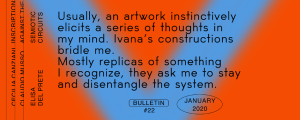Glitch. Interference Between Art and Cinema: A strange attempt
It is always a shame when good ideas fall victim to vague and misleading expedients, for fear they could pass unnoticed. It took a long time before someone went back to talking about Glitch art after his beginning in ’90s. But it nevertheless was very easy to make it a mass phenomenon, wrongly conceived and executed. GLITCH. Interferenze tra arte e cinema, an exhibition curated by Davide Giannella at PAC in Milan, could be the result of a good curatorial project, except for his strained common denominator “Glitch”. A way to justify the intention of expecting to include under the same tendency different art forms and artists who are partially linked to the topic.
We explain to the exhibition’s neophyte public that Glitch art is completely different. Artists like Francesco Vezzoli, Eva Marisaldi, Luca Trevisani, Yuri Ancarani, Diego Perrone, Paolo Gioli and the majority of those who are exhibiting at PAC never had something to do with Glitch. At the beginning, the concept of Glitch was used to identify that inexplicable phenomenon that causes a pulsar suddenly varying its period of rotation. The term of german extraction originates from glitschig, slippery, and it was coined in 1962 by the first American astronaut John Glenn during the Friendship 7 mission, because of an interference during a radio transmission. Since then, it has belonged to the astrophysics language to describe any problem or unexpected electrotechnical variation. Glenn explains: “Literally, a glitch is a spike or change in voltage in an electrical current.”
The term definitively lost its original meaning and assumed an artistic connotation in ’94, thanks to Markus Popp of the Oval, the band from Berlin: that is how Glitch Music was born in the city’s noise environment in the ’90s. Nevertheless, to understand its dense and complicated figurative path, it is necessary to go backwards, passing through New-Media Art and its several subgenres. The year before, 1993, with the arrival of the “dot com”, two european artists called Joan Heemskerk and Dirk Paesmans went to California, headed toward Silicon Valley. When they came back, they designed jodi.org, a website which could re-contextualize the perfection of the interface and the html consequential language, suggesting for the first time an expressive metamorphosis of the Internet, deprived of any utilitarian approach. The World Wide Web was at its first years of life and it had already been deconstructed. Thanks to Tony (Ant) Scott, Glitch Art gained a visual meaning in ’90s, too. This process finally finds his technical and conceptual meaning: a visual outcome, unpredictable and unintentional, caused by chance or by a malfunctioning. Nowadays we all perceive Glitch phenomena, like (Ant) Scott, provoked by mistake by machines, even without human action. In the last five years, Glitch became first a trend and then a frequent diversion for many users thanks to social networks and mass employment of softwares.
The big news and, at the same time, the reason why the exhibition is so successful is the selection the curator thought for the fair which took place inside and during the exhibition. Sixty four artists movies, divided in two programs, and projected every other day; they turn the exhibition complex into an out-and-out multiplex. Movies are the big unexpected exhibition’s protagonists, all the rest in Glitch’s name is superfluous. This exhibition baffles us even when we come back home: it is necessary to study every information Giannella gives us to solve every doubt. The curator himself quotes Jean François Lyotard and considers the postmodern period as the time of the main ideologies’ dissolution and the intellectual impossibility of attributing everything to a genre. So far so good. Then now, it appears inevitable to ask ourselves: if everything is dissolute, why do we have to make all these contemporary expressions converge to a single definition? There is a big inconsistency between the good intentions of this exhibition and the misrepresented information which are offered to the public.
The prequel deals with Giannella’s words about Glitch: “A matter of genres. The attempt to investigate the loose end between different critical systems, the one between contemporary art and cinema.” That is not so clear, he keeps things vague, a little uncertain. And the question of genre between art and cinema – which are not genres – seems to be an essential requirement also because of Rosa Menkman, founder of Glitch Art, who redeemed Glitch as a genre those days. That is not a border violation between art and cinema, those so-called genres, because Glitch Art itself is a genre,so it is already art, an art form that is revealed in cinema, in a video, in music, in the weft and the warp of a cloth – thinking about the great pioneer Jaquard –, in a sculpture – thanks to the latest 3D printers – and so on… but Glitch Art is actually the unintentional outcome of a mistake, of a digital interference.
Glitch: interferenze tra arte e cinema, PAC, Milano. October 11, 2014 – January 6, 2015
by Eleonora Salvi
in Focus on Europe
Jan 19, 2015


























